Ramadhan 2012 / 1433h


Communiqué
Sur la Date de la Fête de l'Aïd 2012
(Le texte de ce communiqué se trouve à http://www.siriusalgeria.net/ram1 2 .htm#a)
L’Association Sirius d’Astronomie tient à travers ce communiqué à informer le public sur les données astronomiques relatives à la nouvelle Lune du mois du Chaoual 143 3 qui détermine la fin du mois du jeûne et donc le jour de l’Aïd. Nous précisons emphatiquement que seul le Comité des Croissants Lunaires du Ministère des Affaires Religieuses est habilité à se prononcer sur la date effective de l'Aïd.
L’Etat de la visibilité du croissant le 17 Août (29 du Ramadhan)
La conjonction lunaire (naissance de la nouvelle lune astronomique) du mois de Chaoual aura lieu le Vendredi 17 Août à 16h54 heure d'Algérie. Or lors du coucher du Soleil ce jour là, le croissant ne sera pas visible d'Algérie vu que la Lune se couchera avant le Soleil pour toutes les Wilayas du pays ainsi d'ailleurs que tout le Monde Arabe et Africain (Ainsi la Lune se couchera 23mn avant le Soleil à Alger) La situation est similaire pour les autres pays arabes pour lequel une observation tant à l'œil nu que télescopique est vaine. Aussi le mois de Ramadhan devrait compter 30 jours et l'Aïd devrait, sur la base de l'observation du croissant lunaire, être célébré le Dimanche 19 Août.
Par contre pour les pays qui ont commencés le jeûne le Samedi et dont le 29 du Ramadhan sera le Samedi 18 Août tels que l'Indonésie, le Pakistan, l'Inde, l'Iran, Oman, l'Afrique du Sud, le Maroc… si l'observation du croissant ce confirme ce soir là, ils célébreront l'Aïd avec nous soit le Dimanche, sinon ils le célébreront le Lundi 20 Août. En fait, l'observation à l'œil nu du croissant ce jour là ne sera possible que d'Afrique du Sud et d'Amérique du Sud, pour les autres pays l'observation locale à l'œil nu est impossible.
Unanimité de la Communauté Astronomique Mondiale
Notons que même le soir du Samedi 19 Août, le croissant lunaire ne pourra être vu d'Algérie. Ceci est a relier au fait que le début du Ramadhan c'est fait en Algérie sur la base d'une Lune qui, quoique née avant le coucher du Soleil, se couchait en même temps que lui et était donc, à l'unanimité de la communauté astronomique mondiale, scientifiquement impossible à observer.
Notons que ces données sur la visibilité du croissant sont en pleine concordance avec les rapports et communiqués sur le sujet émanant des différentes instances scientifiques de par le monde. Nous mentionnerons en particulier l’Union Arabe d’Astronomie et des Sciences de l’Espace dont le siège est à Amman, l'IMCCE (Ex Bureau des Longitudes) à Paris, le South African Astronomical Observatory (SAAO) d'Afrique du Sud, l’US Naval Observatory (Virginia, USA), ainsi que le CRAAG de Bouzaréah. Nous mentionnerons de plus l’ICOP (Islamic Crescents Observation Project - http://www.icoproject.com), qui est la source de référence ayant acquis une crédibilité scientifique sans faille ces dernières années dans le Monde concernant l’observation des croissants lunaires.
Doit-on tenter d’observer le croissant ce Vendredi 17 Août ?
Une Recommandation Pressante au Comité des Croissants Lunaires
Vu la similarité du point de vue astronomique de l'Aïd cette année avec celle de l'année dernière, il est opportun de discuter de la pertinence de la recherche du croissant le 29 du Ramadhan. En effet, vu que la Lune se couchera avant le coucher du Soleil, est-il opportun d’inviter les gens à tenter d’observer un croissant « impossible » ? L’avis de nombre d’astronomes et de légistes est qu’il n’est pas sage de le faire vu que le résultat est connu d’avance avec cependant la possibilité bien réelle que certaines personnes prétendront avoir vu le croissant, ce qui ne manquera pas de créer un problème au niveau des instances en charge d’entériner les rapport d’observation.
Aussi suggérons nous vivement au Comité National des Croissants Lunaires d’adopter cette règle, notamment qu’il ne soit pas demandé aux fidèles de tenter d’observer le croissant lorsque le 29 du Ramadhan la Lune se couche avant le Soleil, ce qui est le cas cette année. Notons que ceci est d’ailleurs une recommandation expresse du Congrès International organisé aux Emirats en Mai 2010 sur le sujet par l’ICOP qui avait réuni des experts tant en jurisprudence (Fiqh) qu’en astronomie.
Nous espérons vivement que les autorités religieuses des différents pays musulmans auront la sagesse de ne pas faire cas de rapports d’observation du croissant le Vendredi soir qui pourraient leur parvenir. Aucune personne normalement constituée ne peut voir un croissant sous l'horizon!
En Résumé
Astronomiquement parlant, l’observation du croissant lunaire en Algérie le Vendredi 17 Août étant rigoureusement impossible vu que la Lune se couchera ce jour là avant le Soleil, le mois de Ramadhan devrait compter 30 jours, et ce tant dans le cas d'une observation locale (Ikhtilaf el-Matali) que généralisée (Tawhid el-Matali). Donc sur la base d'une observation visuelle (et même instrumentale) du croissant, l’Aïd ne devrait donc être célébrée que le Dimanche 19 Août. Nous espérons que le Ministère des Affaires Religieuses soit bien inspiré pour ne pas valider une prétendue observation du croissant qui pourrait lui parvenir le Vendredi soir comme cela fut le cas pour le début du Ramadhan, soit-elle locale ou d’un pays arabe quelconque, ce qui irait à l’encontre des données astronomiques.
Bonne fête de l'Aïd à tous. |
The Global Visibility Maps for the Eid 1433 (Shawwal crescent)
The situation on August 17, 2012 (29th of Ramadhan) |
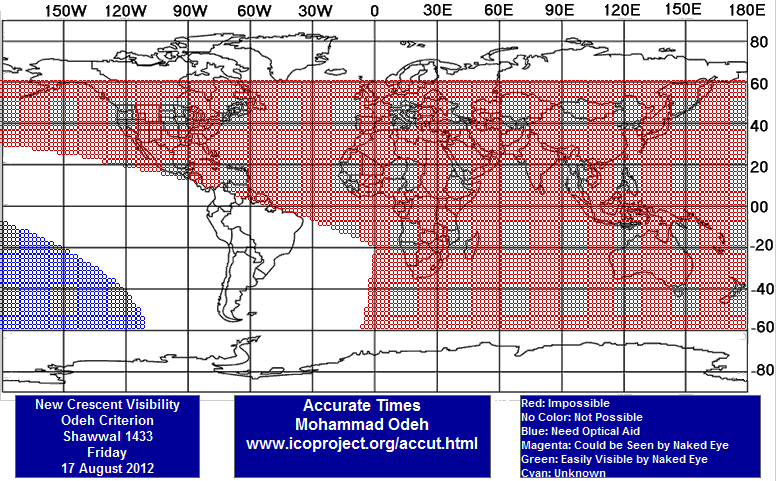 |
And here the situation on August 18, 2012 |
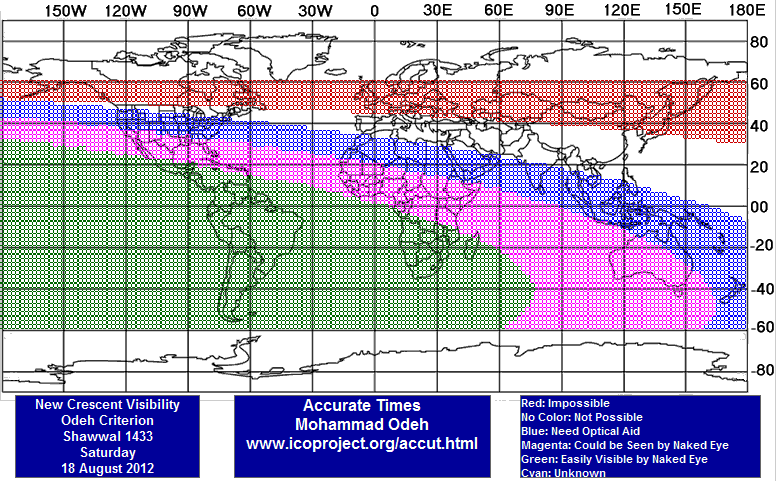 |

بلاغ
حول هلال الشوال (العيد) 1433ه
(يوجد هذا النص على الصفحة: (http://www.siriusalgeria.net/ram12.htm )
تود جمعية الشعرى لعلم الفلك إفادة الجمهور الكريم بالمعطيات الفلكية التالية بشأن اقتران هلال شوال الذي يحدد يوم عيد الفطر لعام 1433.
حول إمكانية رؤية هلال العيد يوم الجمعة 17 أوت
(يوم 29 رمضان)
بناءا على الحسابات الفلكية، سيتم اقتران هلال شوال يوم الجمعة 17 أوت على الساعة 16:54 بالتوقيت المحلي، وبما أن القمر سيغرب قبل غروب الشمس في ذلك اليوم (بـ23 د. بالجزائر العاصمة) فلا يمكن رؤية الهلال على الإطلاق، وبالتالي سنتم رمضان 30 يوما بحول الله، ذلك بناءا على المعطيات العلمية حول إمكانية الرصد هلال العيد يوم الجمعة 17 أوت.
ونذكر أن استحالة رؤية الهلال يوم الجمعة بسبب وقوع القمر تحت الأفق في وقت التحريه هي شأن كل الدول العربية والإسلامية الأخرى. ونحيطكم علما أن هذه الاستنتاجات تتوافق تماما مع تصريحات الهيئات الفلكية العالمية وعلى وجه الخصوص المشروع الإسلامي لرصد الأهلة - ICOP (http://www.icoproject.org) الذي يعتبر المصدر الذي اكتسب مصداقية عالمية بشأن كل ما هو متعلق برصد الأهلة في العالم.
أما البلدان التي بدأت شهر رمضان يوم السبت 20 أوت مثل إندونيسيا, الهند، باكستان، إيران، جنوب إفريقيا، المغرب، فسيحتفلون بعيد الفطر معنا إذا ثبت عندهم هلال الشوال مساء يوم السبت (والإمكانية رؤية الهلال تنحصر فقط على جنوب إفريقيا وجنوب أمريكا)، وإلا فسيحتفلون بالعيد يوم الاثنين 20 أوت.
هل ينبغي لنا تحري الهلال يوم الجمعة 17 أوت؟
بسبب الاستحالة الواضحة لرؤية الهلال ليلة الجمعة وهي ليلة تحري الهلال كون أن القمر يغرب قبل غروب الشمس يطرح السؤال عما إذا كان من المعقول أن ندعو الناس لتحري هذا الهلال "المستحيل"؟ يرى العديد من الفلكيين والفقهاء أنه ليس من الحكمة تحري الهلال ونحن نعرف النتيجة يقينا، بل قد يؤدي إلى إمكانية ادعاء بعض الناس رؤية الهلال من باب التوهم مما سيحدث حرجا على مستوى الجهات المعنية لرد شهادتهم. هذا وقد أوصى المشاركون في مؤتمر الإمارات الفلكي الثاني المنعقد في شهر ماي 2010 بأبو ظبي والمنظم من طرف هيئة المشروع الإسلامي لرصد الأهلة "إذا كان القمر يغيب قبل الشمس في اليوم التاسع والعشرين، لا يجب أن يدعى الناس لتحرّي الهلال أصلا. وعلى هذا الأساس، نتمنى أن الهيئات الشرعية في الدول الإسلامية المختلفة تكون لها حكمة عدم قبول شهادات الرصد التي قد تظهر يوم الجمعة وإن تم ذلك فهي ثبوت هلال المستحيل.
خلاصة:
بسبب استحالة رؤية هلال شوال 1433 يوم الجمعة 17 أوت كون أنه يغرب قبل الشمس، فنتوقع استكمال رمضان 30 يوما ولا يمكن أن يكون يوم العيد من الناحية الرصدية إلا يوم الأحد 19 أوت إن شاء الله وذلك في كل من الحالة الأخذ بمبدأ توحيد المطالع وحالة الأخذ باختلافها.
تؤكد جمعية الشعرى لعلم الفلك أن الجهة الوحيدة التي لها شرعية إصدار فتوى بشأن بداية رمضان هي لجنة الأهلة التابعة لوزارة الشؤون الدينية. في حالة اعتماد وزارة الشؤون الدينية شهادة رصد مزعوم للهلال ذلك اليوم وطنيا كانت أو عربيا، فينبغي أن تتحمل مسؤولية هذا التعارض مع المعطيات الفلكية كاملة، ولكي لا يقال أن هناك شرخ بين العلم والدين.
فعيد فطر مبارك، أعاده الله على المسلمين بالأمن والأمان والخير والسلام.
|

Communiqué
Sur la Date du Début du Ramadhan 2012
(Le texte de ce communiqué se trouve à http://www.siriusalgeria.net/ram12.htm)
L’Association Sirius d’Astronomie tient à travers ce communiqué à informer le public sur les données astronomiques relatives à la nouvelle Lune du mois de Ramadhan 1433 qui détermine le début du mois du jeûne. Nous précisons emphatiquement que seul le Comité des Croissants Lunaires du Ministère des Affaires Religieuses est habilité à émettre la fatwa sur la date effective du début du Ramadhan.
La nuit du 29 du mois de Chaabane ou "Nuit du Doute" étant le Jeudi 19 Juillet 2012, le croissant du mois lunaire correspondant au mois de Ramadhan 1433 sera impossible à observer de tout le territoire national tant à l'œil nu qu'avec des instruments optiques vu que la Lune se couchera en même temps que le Soleil. Il découle de l'impossibilité de l'observation du croissant lunaire que le 1er du Ramadhan ne pourra donc être le Vendredi 20 Juillet mais le Samedi 21 Juillet si l'on s'en tient a l'observation visuelle du croissant. Notons que même si était permise l'observation d'autres pays tels que ceux d'Afrique australe pour lesquels la Lune se couche après le coucher, l'observation est rigoureusement impossible à l'œil nu et marginalement possible au télescope. Seuls les pays qui ne se soucient pas de l'observation visuelle et qui donc se contentent de l'occurrence de la conjonction avant le coucher du Soleil, ce qui est un avis bien minoritaire dans le Monde Musulman, pourraient débuter le mois de carême le Vendredi 20 Juillet. Mentionnons aussi que depuis la révolution Libyenne, les autorités de ce pays se sont jointes au concert des pays musulmans qui se basent sur l'observation du croissant comme annonciateur du mois.
Notons que la conjonction Lune - Soleil aura lieu le Jeudi 19 Juillet, à 5h24mn du matin heure locale, mais la Lune se couchant en même temps que le Soleil ce jour là et même avant lui pour certaines régions du Monde Arabe, ceci rendra nécessaire la complétion du mois du Chaabane à 30 jours et donc de débuter le Ramadhan le Samedi 21 Juillet.
Vu que cette année quasiment tous les pays du Monde Musulman s'accordent quant au début du Chaabane et donc sur la date de la "Nuit du Doute", nous nous acheminons vers un début de Ramadhan unifié le Samedi 21 Juillet, en espérant qu'aucune déclaration intempestive et mal informée ne vienne troubler cette concorde pointant à l'horizon.
Bon Ramadhan à tous, et que Dieu accepte durant ce mois notre jeûne et nos actions.

Ramadan 2012 Press Release in Arabic
بلاغ
حول هلال رمضان 1433ه
(يوجد هذا النص على الصفحة: (http://www.siriusalgeria.net/ram12.htm )
تود جمعية الشعرى لعلم الفلك إخبار الجمهور الكريم ببعض
المعلومات
الفلكية
بشأن
هلال
شهر رمضان وما يمكن استنتاجه
حول
يوم بداية
شهر
الصيام
المبارك.
بناءا على حسابات فلكية
دقيقة،
فإن اقتران هلال رمضان
1433هـ
المعظم سوف يتم يوم الخميس19
جويلية
على الساعة
05:24
صباحا
بالتوقيت المحلي.
وبما أن القمر يغرب مع الشمس من كامل التراب الوطني، فإنه يستحيل
رؤية الهلال وهو تحت الأفق في يوم 19 جويلية الموافق لـ29 شعبان مما
سيلزم علينا اكتمال شهر شعبان 30 يوما، وسيجعل أول رمضان بإذن الله
يوم السبت 21 جويلية 2012.
نضيف أن رؤية الهلال مستحيلة حتى في بلدان متواجدة جنوب القارة
الإفريقية والتي سيبقى القمر بضع دقائق بعد غروب الشمس، فلا يمكن
رؤية الهلال هناك بالعين المجردة، ويمكن رؤيته بالتلسكوب بصعوبة.
وأما بالنسبة للبلدان العربية،
فالرؤية مستحيلة بالعين المجردة وبالتلسكوب.
تؤكد جمعية الشعرى لعلم الفلك أن الجهة الوحيدة التي لها شرعية إصدار
فتوى بشأن بداية رمضان هي لجنة الأهلة التابعة لوزارة الشؤون
الدينية. ونتمنى أنها ستأخذ بعين الاعتبار المعطيات العلمية اليقينية
بشأن
إمكانية
الرؤية. |
Unanimity of the Astronomical Community
about the Impossibility to See the Crescent on Thursday Evening
- The astronomical community stated that the crescent would be invisible by naked eye on that day.
ICOP issued a press release stating that the Moon is nowhere to be seen by naked eye throughout the world . It could however potentially be seen by telescope from South Africa and with slighter better chance from South America. Some 23 professional astronomers and astronomy experts signed this press release.
See the Press release in English here below or from the original page.
- See here the statement of Dr.Hassan Basurah, the well-known Saudi astronomer reaching the same conclusions.
- The Research Center for Astronomy, Astrophysics and Geophysics at Algiers (CRAAG) in its internal report on the crescent visibility emphasized the impossibility to see the crescent by naked eyes throughout Algeria. This is also apparent from the ephemerides put on their site. Here is the line for Thursday 19th of July where clearly the Moon sets precisely with the Sun (Jeudi 19 Juillet 2012)

|
A Magic Diagram (Muhib N.Durrani)
To understand with insight the crescent observability according to latitude
in various World cities, by Muhib N.Durrani
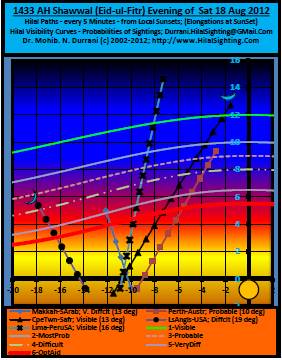
For more hilal visibility curves, go to the HILAL-SIGHTING site
(Click on the diagram for a larger version)
The Moon on the Horizon
(19 & 20 July 2012)
Un croissant lunaire se couchant avec le Soleil est invisible!
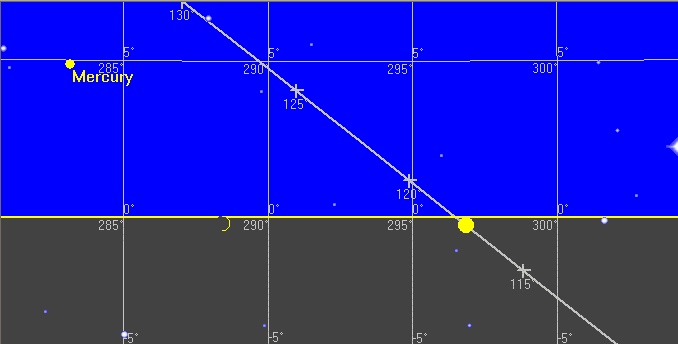 |
| The Moon (The small yellow arc at left on the horizon) on July 19 is setting along with the Sun (Small plain yellow disk). Note that Mercury, although a small disk in its aspect, is roughly in the same direction than the crescent Moon. According to L.Bonatero (See below) from Blida University, such a crescent could be seen visually! |
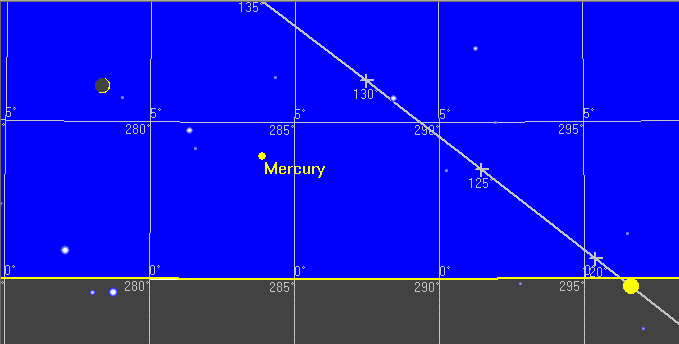 |
| On the next evening, the Moon was standing much higher in the sky at sunset time. Yet no one reported to us of having sighted it on that evening, which
is at least a clear indication that it was a challenging sighting.
What about the Moon the day before? |
The Position of the Moon on the Horizon at Algiers
| On August 17, 2012 |
 |
At sunset, the crescent has set 24 mn earlier and is well below the horizon. The impossibility of its sighting should lead to the completion of Ramadhan to 30 days |
On August 18, 2012 |
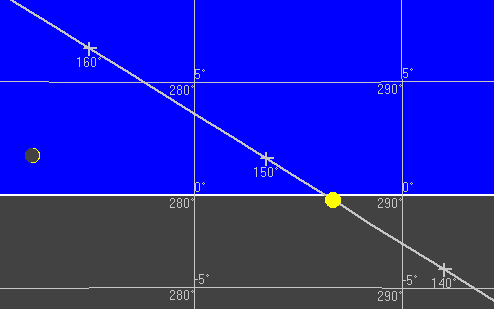 |
| Even the day after conjunction, the crescent, although of more than 24h of age, is still too close from the horizon at sunset to be seen in Algeria by any mean. |
بيان المشروع حول رؤية هلال رمضان
ICOP Report in Arabic
السبت 21 تموز/يوليو غرّة شهر رمضان المبارك باعتماد رؤية الهلال
في ظاهرة قليلة التكرار، بدأ جلّ الدول الإسلامية شهر شعبان في نفس اليوم، وبالتالي ستتحرى معظم دول العالم الإسلامي هلال شهر رمضان سوية يوم الخميس التاسع والعشرين من شهر شعبان الموافق 19 تموز/يوليو، وفي هذا اليوم تستحيل رؤية هلال رمضان 1433 هـ من جميع المناطق الشمالية من العالم، وبعض المناطق الوسطى، وهذا يشمل العراق وبلاد الشام وجزءا من الجزيرة العربية، وذلك بسبب غروب القمر قبل غروب الشمس، أما ما تبقى من مناطق العالم العربي فإن رؤية هلال شهر رمضان منها يوم الخميس غير ممكنة إطلاقا بسبب غروب القمر مع الشمس أو بعده بدقائق معدودة لا تسمح برؤية الهلال حتى باستخدام أكبر التلسكوبات الفلكية.
فالقمر يوم الخميس سيغيب قبل غروب الشمس بدقيقتين في بغداد، وقبل غروب الشمس بدقيقة في دمشق وبيروت، ومع غروب الشمس في القدس وعمّان وتونس والجزائر، وبعد غروب الشمس بدقيقة واحدة في الكويت، وبعدها بدقيقتين في المنامة والقاهرة وطرابلس، وبعدها بثلاث دقائق في الرياض والدوحة ومسقط والرباط، ورؤية الهلال في جميع هذه المناطق السابقة يمكن وصفها بالمستحيلة لأن القمر الذي يغيب بعد الشمس بدقيقتين ونصف، تكون الحافة السفلية لقرصه قد بدأت بالغروب قبل اكتمال غروب الحافة العليا للشمس، إذ أن قرص القمر يحتاج إلى حوالي دقيقتين ونصف ليغرب من حافته السفلى إلى العليا. في حين سيغيب القمر بعد الشمس بست دقائق في مكة المكرمة، وبعدها بثمان دقائق في صنعاء، وبعدها بـ 10 دقائق في الخرطوم وجيبوتي، وبعدها بـ 14 دقيقة في مقديشو، وبعدها بـ 19 دقيقة في موروني، ورؤية الهلال في جميع هذه المناطق السابقة غير ممكنة حتى باستخدام التلسكوب الفلكي. لكن رؤية الهلال يوم الخميس ممكنة بالتلسكوب من أقصى جنوب القارة الإفريقية ومن أمريكا الجنوبية فقط.
هذا ويناشد المشروع الإسلامي لرصد الأهلة المسؤولين في الدول الإسلامية التثبت الدقيق من الشهود إذا تقدموا للشهادة يوم الخميس، إذ لم يثبت من خلال المعايير وسجلات أرصاد الأهلة العالمية الممتدة منذ العهد البابلي وحتى يومنا هذا تسجيل رؤية للهلال سواء بالعين المجردة أو باستخدام التلسكوب في مثل هذه الظروف الموجودة في العالم العربي يوم الخميس. ونرى أن الإعلان عن رؤيته في ذلك اليوم بمثابة تكرار الإعلان للعالم أننا نمتلك في منطقتنا من بصره أقوى وأفضل من أكبر التلسكوبات العالمية، وأن عليهم استخدام هؤلاء الشهود للأبحاث العلمية عوضا عن التلسكوبات الضخمة التي لا ترى الهلال الذي يرونه. ويأتي حرص المشروع على عدم قبول أي دعوى برؤية الهلال من منطقتنا يوم الخميس حتى لا نكون مهملين للعلم والعقل، الذين دعت شريعتنا الغراء إلى إعلاء أمرهما.
هذا وتجدر الإشارة إلى أن العديد من الفقهاء والفلكيين يرون أنه لا داعي لتحري الهلال بعد غروب شمس يوم الخميس من المناطق التي يغيب فيها القمر قبل الشمس، لأن القمر غير موجود في السماء وقتئذ، وعليه فإن رؤية الهلال مستحيلة في ذلك اليوم استحالة قاطعة من تلك المناطق، وهذا معروف مسبقا من خلال الحسابات العلمية القطعية، وقد كانت إحدى توصيات مؤتمر الإمارات الفلكي الثاني والذي حضره فقهاء ومتخذو قرار من العديد من الدول الإسلامية ما نصه: " إذا قرر علم الفلك أن الاقتران لا يحدث قبل غروب الشمس أو أن القمر يغرب قبل الشمس في اليوم التاسع والعشرين من الشهر فلا يدعا لتحري الهلال." وقد أقرّ الفقهاء أن لا تعارض بين هذه التوصية وبين سنة الرسول صلى الله عليه وسلم بتحري الهلال، إذ أن هذه التوصية متعلقة فقط بالحالات التي نعلم فيها مسبقاً أن القمر غير موجود في السماء بناء على معطيات قطعية، وبالتالي فإن تحرّيه ونحن متأكدون أنه غير موجود هو تهميش للعقل والعلم. ومن بين الفقهاء الذين دعوا لمثل هذه التوصية حتى قبل انعقاد المؤتمر معالي الشيخ عبد الله بن منيع عضو هيئة كبار العلماء في المملكة العربية السعودية ومستشار الديوان الملكي هناك، إضافة إلى أن هذه التوصية معتمدة بطبيعة الحال في بعض الدول الإسلامية التي تعتمد رؤية الهلال أساسا لبدء الشهر الهجري.
وعلى الرغم من جميع هذه الحقائق فإنه إذا سارت الأمور هذا العام كما كانت تسير عليه في السنوات السابقة، فإن معظم الدول العربية ستبدأ صيامها يوم الجمعة. ففي بعض البلدان تقبل شهادة الشاهد حتى لو تعارضت مع معايير رؤية الهلال بحجة أنه لا يمكن ردّ شهادته والقمر موجود في السماء، وكثيراً ما تقدم الشهود بشهادتهم بالرؤية في مثل هذه الظروف. وفي بلدان أخرى، يبدأ الشهر إذا غرب القمر بعد غروب الشمس بغضّ النظر عن إمكانية رؤيته. وللأسف، وفي ظلّ إعلان هذه الدول ثبوت رؤية الهلال، فإن المعمول به في كثير من الدول الأخرى هو اتباع تلك الإعلانات لأسباب متعددة. ولكن جرت العادة أن لا تعلن سلطنة عُمان ولا المملكة المغربية رؤية الهلال بمثل هذه الظروف المستحيلة أو غير الممكنة، فهناك احترام واضح لعلم الفلك في هاتين الدولتين، ولم نشهد خلال السنوات الأخيرة الماضية أي إعلان مخالف للحقائق العلمية من قبلهما، وتجدر الإشارة إلى أن ليبيا قد أعلنت أنها أصبحت تولي رؤية الهلال أهمية حقيقية ولا تعلن بدء الشهر إلا برؤية حقيقية وفعلية للهلال. وبناء على هذا فمن المتوقّع أن تعلن كثيرٌ من الدول العربية شهر رمضان يوم الجمعة، أما سلطنة عُمان وليبيا والمغرب فالمتوقع أن تعلنه يوم السبت، وهذا الطرح متوقع إذا سارت تلك الدول على نفس النهج الذي اعتمدته طيلة السنوات السابقة بالنسبة لعُمان والمغرب، إلا أننا حقيقة نتمنى أن يتحسن الوضع في عالمنا العربي، وأن يصبح للعلم احترام أكبر، فإما أن يعلن أننا سنصوم يوم الجمعة لا لرؤية الهلال بل لوجود القمر في السماء بعد غروب الشمس أو أن يعلن بدء الصوم يوم السبت لعدم إمكانية رؤية الهلال يوم الخميس.
ولمعرفة نتائج رصد هلال شهر رمضان، يمكن زيارة موقع المشروع الإسلامي لرصد الأهلة على شبكة الإنترنت على العنوان (http://www.icoproject.org)، حيث أنشئ المشروع عام 1998م ويضم حاليا أكثر من 400 عضو من علماء ومهتمين برصد الأهلّة وحساب التقاويم. هذا ويشجع المشروع المهتمين في مختلف دول العالم على تحري الهلال و إرسال نتائج رصدهم إلى المشروع عن طريق موقعه على شبكة الإنترنت، حيث تنشر تباعا بعد تدقيقها وتمحيصها.
الخارطة أدناه تبين إمكانية رؤية هلال شهر رمضان يوم الخميس 19 تموز/يوليو من جميع مناطق العالم، بحيث أن:
· رؤية الهلال مستحيلة من المناطق الواقعة في اللون الأحمر بسبب غروب القمر قبل غروب الشمس أو/و بسبب حصول الاقتران السطحي بعد غروب الشمس.
· رؤية الهلال غير ممكنة لا بالتلسكوب ولا بالعين المجردة من المناطق غير الملونة.
· رؤية الهلال ممكنة فقط باستخدام التلسكوب من المناطق الواقعة في اللون الأزرق.
· رؤية الهلال ممكنة باستخدام التلسكوب من المناطق الواقعة في اللون الزهري، ومن الممكن رؤية الهلال بالعين المجردة في حالة صفاء الغلاف الجوي التام والرصد من قبل راصد متمرس.
· رؤية الهلال ممكنة بالعين المجردة من المناطق الواقعة في اللون الأخضر.
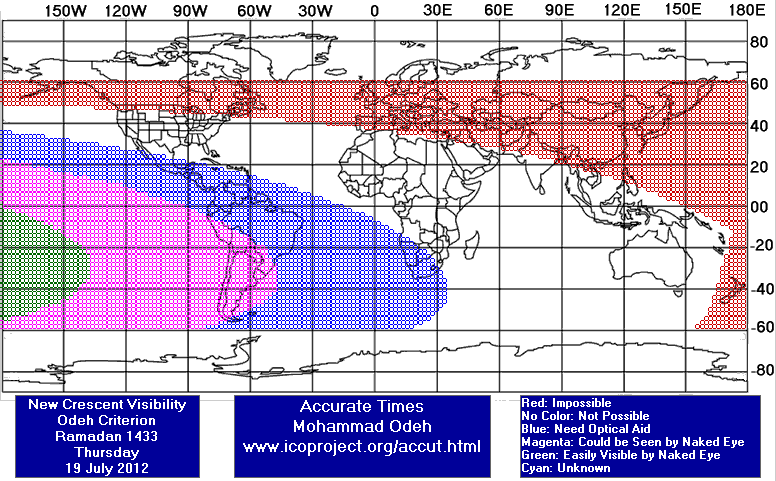
الموقعون على البيان (مرتبة حسب تاريخ وصول الموافقة على إضافة التوقيع):-
1- د.هيمن زين العابدين متولي / أستاذ الفلك وعلوم الفضاء بكلية العلوم - جامعة القاهرة – مصر.
2- الأستاذة بسمة ذياب / أمين سر المشروع الإسلامي لرصد الأهلة، الأردن.
3- أ.د. شرف القضاة / رئيس قسم أصول الدين في الجامعة الأردنية سابقا – الأردن.
4- الأستاذ شرف السفياني / نائب رئيس الجمعية الفلكية بجده – السعودية.
5- م. محمد بن سالم البوسعيدي / خبير المرصد الفلكي - شؤون البلاط السلطاني – سلطنة عُمان.
6- د.م. جلال الدين خانجي / خبير فلك شرعي ومدير جامعة إيبلا- حلب - سوريا.
7- م. عمار بن سالم الرواحي / الفلكي بوزارة الأوقاف والشؤون الدينية – سلطنة عُمان.
8- أ.د. جمال ميموني / أستاذ الفلك في جامعة قسنطينة – قسنطينة – الجزائر.
9- م. محمد شوكت عودة / مدير مركز الفلك الدولي – الإمارات.
10- م. صخر سيف / جمعية الإمارات للفلك وعضو اللجنة الرسمية لتحري الهلال في دولة الإمارات.
11- م. منصور اشقيفة / مدير مكتب الفلك والمراصد في المركز الليبي للاستشعار عن بعد وعلوم الفضاء – ليبيا.
12- الأستاذ عدنان عبدالمنعم قاضي / باحث في علاقة علم الفلك بالمسائل الإسلامية - السعودية.
13- م. علي العمراوي / خبير في الفلك الشرعي وعضو الجمعية الفلكية المغربية – المملكة المغربية.
14- الأستاذ مروان الشويكي / خبير فلكي وأمين القبة الفلكية في سلطنة عُمان – سلطنة عُمان.
15- د. صبيح الساعدي / باحث فلكي وخبير بوزارة التربية والتعليم – سلطنة عُمان.
16- أ.د. عبد القادر عابد / خبير في الفلك الشرعي وعضو اللجنة الرسمية لإثبات الأهلة في الأردن.
17- السيد سليمان البوسعيدي / فلكي – شؤون البلاط السلطاني، سلطنة عُمان.
18- د. عبد الخالق الشدادي / أستاذ الفلك في جامعة محمد الخامس- الرباط – المملكة المغربية.
19- د. إلياس محمد فرنيني / أستاذ الفيزياء والفلك - جامعة الإمارات العربية المتحدة.
20- أ.د. حسن باصرة / رئيس قسم الفلك في جامعة الملك عبد العزيز في جدة – السعودية.
21- أ.د. علي الشكري / أستاذ الفيزياء والفلك في جامعة الملك فهد للبترول والمعادن – السعودية.
22- أ.د. نضال قسّوم / أستاذ الفلك في الجامعة الأمريكية في الشارقة – دولة الإمارات.
23- د. معاوية شداد / أستاذ الفلك في جامعة الخرطوم – السودان.
توقع رؤية هلال أول الشهر رمضان
(ICOP site)
سيحدث الاقتران المركزي (المحاق المركزي) يوم الخميس 19 تموز / يوليو 2012 في الساعة 04:24 بالتوقيت العالمي بمشيئة الله
إمكانية رؤية الهلال يوم الخميس 19 تموز / يوليو 2012 ويوم الجمعة 20 تموز / يوليو 2012 موضحة في الأشكال التالية باستخدام برنامج المواقيت الدقيقة باعتماد معيار عودة، بحيث:-
-
رؤية الهلال مستحيلة من المناطق الواقعة في اللون الأحمر بسبب غروب القمر قبل غروب الشمس أو/و بسبب حصول الاقتران السطحي بعد غروب الشمس.
-
رؤية الهلال ممكنة باستخدام التلسكوب فقط من المناطق الواقعة في اللون الأزرق.
-
رؤية الهلال ممكنة باستخدام التلسكوب من المناطق الواقعة في اللون الزهري، ومن الممكن رؤية الهلال بالعين المجردة في حالة صفاء الغلاف الجوي التام والرصد من قبل راصد متمرس.
-
رؤية الهلال ممكنة بالعين المجردة من المناطق الواقعة في اللون الأخضر.
-
رؤية الهلال غير ممكنة بالعين المجردة أو بالتلسكوب من المناطق غير الملونة، على الرغم من غروب القمر بعد غروب الشمس ومن حصول الاقتران السطحي قبل غروب الشمس، وذلك بسبب قلة إضاءة الهلال و/أو بسبب قربه من الأفق.
-
يرجى ملاحظة أن الأشكال أدناه تبين إمكانية رؤية الهلال في المناطق الواقعة بين خطي عرض 60 شمالا و60 جنوبا.
الخميس 19 تموز / يوليو 2012

الجمعة 20 تموز / يوليو 2012
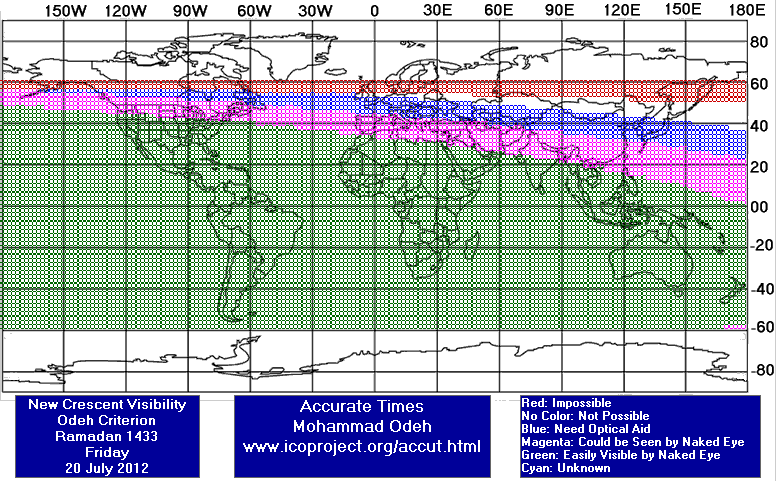
باعتماد التقويم الهجري العالمي المبني على حساب إمكانية رؤية الهلال، فإن بداية الشهر في النطاق الشرقي تكون يوم الجمعة 20 تموز / يوليو 2012 ، وبداية الشهر في النطاق الغربي تكون يوم الجمعة 20 تموز / يوليو 2012 . الرجاء ملاحظة أن التقويم الهجري العالمي يعتمد على الحسابات المسبقة ( اي لا ينتظر الرصد العملي و رؤية الهلال ) و هو يتبنى معياراً معينا لبدء الشهر الهجري الجديد .و قد تتبنى بلدك او منظمتك معياراً آخر لبدء الشهر لذا فإننا ننصح و بشدة أن يتم الاطلاع عما جاء في صفحة التقويم الهجري العالمي في موقعنا قبل إصدار اي أحكام .
ستضاف نتائج تحري الهلال وبداية الشهر
الرسمية في مختلف الدول الإسلامية في هذه الصفحة إن شاء الله فور
استلام نتائج الرصد من قبل أعضاء المشروع الإسلامي لرصد الأهلة.
Saturday, July 21:
the Beginning of the Month of the Blessed Ramadhan
in accordance to the crescent sighting- (ICOP press release in
English)
In a rare opportunity, the majority of the Muslim countries started the month of Shaaban in the same day, hence the majority of the Muslim countries in the world would try to sight the new moon of Ramadhan on the 29th of Shaaban, which would correspond to the 19th of July. On this day, it would be impossible to sight the new moon of Ramadhan 1433 H from all northern locations and some central locations in the world. This would include Iraq, the country of Sham (Syria), and part of the Saudi Arabia peninsula. This is due to the setting of the moon before sunset. For the rest of the Arab world, the sighting of the new moon of Ramadhan on Thursday will not be possible due to setting of the moon at the same time as the sun or few minutes after the sun even if the largest telescope is used.
On that day, Thursday, the moon will set two minutes before sunset in Baghdad, and one minute in Damascus and Beirut. It will set with the sun in Qods, Amman, Tunis, and Algiers. It will set two minutes after sunset in Manama (Bahrain), Cairo, and Tripoli. It will set three minutes after sunset in Riyadh, Doha, Muscat and Rabat. The sighting of the moon in all these countries could be described as impossible because the moon that sets two minutes and half after the sun, its bottom edge would start setting before the top edge of the sun has completely set as it takes two minute and half for the moon to set completely, from bottom to the it top. While the moon will set six minutes after the sun in Noble Makkah; and 8 minutes in Sana’a; and 10 minutes in Khartoum and Djibouti; and 14 minutes Mogadishu; 19 minutes in Moroni (Comoros). In all these locations, the moon is not possible to seen even using telescope. However, it is possible to seen only in the far southern Africa and Southern America.
The Islamic Crescents’ Observation Project (ICOP) urges the authorities in the Muslim countries to take every precaution possible to confirm with certainty all sighting reports on Thursday; as all the data taken throughout the years worldwide that goes as far back as the Babylonian era until our present day, in similar conditions report the impossibility of the sighting of the moon with either unaided or telescope aided sights. We think that asking for the sighting of the moon on that day is virtually an announcement to the world that some of us have better sight than the telescope. We then think, that these people should used instead of the telescopes for scientific studies, that is why we voice our concern so that we are not heedless of science and intellect which Shari’ah upholds.
It should be noted that many Shari’ah scholars and Astronomers do not see any need to observe the new moon on Thursday in the locations where the moon sets before the sun since the moon at that time is not in the sky and seeing is impossible. All this is known ahead of time from definitive scientific calculations. Indeed one of the recommendations of the second annual Emirates conference on Astronomy, which was attended by many Astronomers and scholars of Shari’ah, stated: ”If it is declared by astronomy that the conjunction does not happens before sunset, or the moon sets before the sun in the 29th day of month, we should not ask people to go out and observe the moon.” The Shari’ah scholars agreed that this is not in conflict with the sunnah of our beloved messenger, peace be upon him, as it is only when we know ahead of time that the moon is not there to be seen based on concrete evidence. So observing the moon on that day knowing positively that the moon is not there to be seen is a marginalization of intellect and science. Ma’aly Al-Sheikh Abdullah ben Manii’, a member of the “organization of major scholars” in the Kingdom of Saudi Arabia and the consultant for the king, is one scholar Amongst those scholars in support of this opinion. This advice is observed by few Muslim countries which consider the sighting of the moon as a condition for starting the Hijri months.
Despite all these facts, if, this year, things go the way they have been going the previous years, the majority of the Arab countries would start the fasting on Friday. In few countries, they accept reports that contradict Astronomical data and scientific calculations claiming that reports of a sighting by any witness should not be refuted while the moon is in the sky. And we saw many witnesses reporting the sighting of a moon that was not there.
In other countries, the month starts as long as the moon sets after the sun regardless of it being able to be seen or not. Unfortunately, in the light of some countries’ reports that the moon has been seen, other countries follow and accept these reports for many reasons. However, usually, Oman and the kingdom of the Maghreb do not report such erroneous sightings. There is a clear respect of Astronomy in these two countries, and in the last few years, we have not seen any report contradicting the scientific facts.
It is worthy to mention that Libya announced that they would give this matter the importance it deserves, and would not start a month without is genuine moon sighting.
Based on the above, it is expected that many Arab countries would announce the beginning of the month of Ramadhan on Friday. However, The Sultanate of Oman, the Kingdom of the Maghreb and Libya are expected to announce the start of fasting on Saturday because of the impossible sightings of the moon on Thursday.
To find out about the results of the observation of the moon throughout the world for the month of Ramadhan for this year, please visit the “Islamic Crescents’ Observation project (ICOP)” at the following web site: http://www.icoproject.org. The Project was started in 1998, and presently has more than 400 members of which are scientist interested in observing the moon and calculating and generating calendars. We encourage everyone interested in every country to observe the moon and send their report to ICOP at the above web site which would be published after confirmation.
The attached map shows the possibility of the moon sightings on Thursday July 19th throughout the world as follows:
-
Red colored area: Moon impossible to be seen due to the moon setting before the sun or the conjunctions, happens after sun set.
-
Non-colored area: Sighting of the moon is impossible with unaided or aided eyes.
-
Blue colored area: The sighting of the moon is possible only with the aid of a telescope.
-
Magenta colored area: The sighting is possible when using a telescope, and also possible with unaided eye if weather conditions are clear.
-
Green colored area: The sighting is possible with the eye without any need to external aid
Signatories to this statement listed in chronological order of receipt:
-
Dr. Hayman Zin Al-Abedeen Metwally: Professor of Astronomy and sciences of the universe at the science college, Cairo University
-
Professor Basma Diab: Secretary, Islamic Crescents’ Observatory Project (ICOP).
-
Dr Sharaf Al-qudhah: former president of Usuludeen, University of Jordan
-
Professor Sharaf Al-Sufyani: Vice president, Astronomical society in Jeddah, Saudi Arabia.
-
Mohammad Ben Salem Al-Bous’idi: Expert Astronomy Observations, Royal Court affairs, Sultanate of Oman
-
Dr Jalal Addin Khanji: Expert Shar’I Astronomy & Provost of the University of Ibla, Halab, Syria.
-
Ammar Ben Salem Al-rouwahi: Astronomer, the Minister of the Endowment and religious affairs, Sultanate of Oman
-
Dr Jamal Mimouni: Professor of Astronomy at the University of Constantine, Algeria
-
Mohammad Odeh: Director, The International center of Astronomy, Emirates
-
Sakhr Saif: Emirates Society of Astronomy and member of the official delegation for the crescent observation, Emirates
-
Mansour Ashkifa: Director, office of Astronomy and Crescent observation at the Libyan Center for Remote sensing and Space Sciences, Libya
-
Professor Adnan Abdel Mun’im Quadhi: Researcher, Astronomy and Islam, Saudi Arabia
-
Ali Al-Amraoui: Official at the ministry of endowment, Salah times and crescent observation, Kingdom of the Maghreb
-
Marwan Al-Shawaiki: Astronomy expert and director of the observatory tower in the Sultanate of Oman, Sultanate of Oman
-
Dr. Sabih Al-sa’idi: Astronomy researcher and expert, Ministry of Education, Sultanate of Oman
-
Dr. Abdel Kader Abed: Expert, Shar’i Astronomy, member official committee of the Crescent observation, Jordan
-
Sulaiman Al-Bous’idi: Astronomer, Royal Court Affairs, Sultanate of Oman
-
Dr. Abdel Khaleq Al-Shaddadi: Professor of Astronomy, University Mohammad V, Rabat, Kingdom og the Maghreb
-
Dr. Ilias Mohammad Fernini: Professor of Physics and Astronomy, University of the United Arab Emirates, UAE
-
Dr. Hasan Basura: President school of Astronomy, University of the King Abdul Aziz in Jeddah, Saudi Arabia
-
Dr. Ali Al-Shukri: Professor of Physics and Astronomy, King Fahd University of Petroleum and minerals, Saudi Arabia
-
Dr. Nidhal Guessoum: Professor of Astronomy, Al-Shariqah American University, UAE
-
Dr. Muawia Shaddad: Professor of Astronomy, University of Khartoum, Sudan
|
Quant Bonatiro Brouille les Cartes :
Bonjour les Dégats
"Plusieurs Sources l'affirment : Vendredi, Premier Jour du Ramadhan", ainsi titre le grand journal francophone "Le Quotidien d'Oran" dans son édition du Mardi 17 Juillet en réponse à notre communiqué. Bonatiro est en effet appelé
à la rescousse pour commenter et et inverser de fait nos conclusions. Le résultat est un tissu de confusion
(Voir ci-dessous). En passant, il commet deux erreurs astronomiques majeures de quoi faire recaler tout amateur d'astronomie:
1- La Lune se couche après le Soleil le Jeudi et est donc visible. En fait elle se couchera avec le Soleil en Algérie du Nord comme on peut le voir par exemple de l'extrait des éphémérides de la Lune et du Soleil du CRAAG plus haut. (Notons que les quelques secondes de difference n'ont aucune signification pratique vu le diametre angulaire des deux astres et l'extreme difference de contraste).
2- Ce qui compte est l'élongation angulaire et vu sa valeur de 8°, le croissant d'une telle Lune peut'etre vu; ce qui est trivialement faux (Voir le diagramme içi).
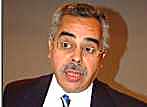 |
Bonatiro, a legacy of wrong predictions and false statements
Bonatiro et ses fausses prédictions
بوناطيرو وتنبؤاته الخاطئة |
|
|
|
Voir aussi notre Droit de Réponse que "Le Quotidien d'Oran " n'a pas osé publier

"Plusieurs Sources l'Affirment : Vendredi, Premier jour du Ramadhan"
par Moncef Wafi, Quotidien d'Oran, Mardi 17 Juillet 2012
Tout porte à croire que le premier jour du Ramadhan 1433 sera ce vendredi 20 juillet, même si, comme l'indique l'association Sirius d'Astronomie, seul le Comité des Croissants Lunaires du ministère des Affaires religieuses est habilité à émettre la fatwa sur la date effective du début du Ramadhan.
Pour le Conseil Européen de la Fatwa et de la Recherche ou le président de l'Exécutif des Musulmans de Belgique, le mois du carême devrait débuter ce vendredi pour être clôturé le 19 août, se basant sur des éléments scientifiques et théologiques. En Algérie et un peu partout dans les pays arabes, l'annonce du premier jour du jeûne est sujet à des querelles intestines sur fond de divergences politiques. Pour Sirius, si la nuit du 29 du mois de Chaabane ou « Nuit du doute » étant le jeudi 19 Juillet 2012, le croissant du mois lunaire correspondant au mois de Ramadhan 1433 sera impossible à observer de tout le territoire national tant à l'œil nu qu'avec des instruments optiques, le premier jour du Ramadhan sera le samedi 21 juillet. Cette certitude est d'autant renforcée, selon la même source, par l'unification de la date de la « Nuit du doute » à tous les pays musulmans. Répondant aux annonces du vendredi, le communiqué de l'Association explique que seuls les pays qui ne se soucient pas de l'observation visuelle et qui se contentent de l'occurrence de la conjonction avant le coucher du soleil jeûneront le 20 juillet.
Pour elle, ce procédé reste minoritaire dans le monde musulman et quand la politique s'invite au religieux, le communiqué cite l'exemple de la Libye post-Kadhafi qui s'est jointe au concert des pays musulmans qui se basent sur l'observation du croissant comme annonciateur du mois. Vendredi, samedi, le débat est derechef lancé, comme à chaque année, et comme à pareille circonstance, la contradiction vient du très médiatique Loth Bonatiro, docteur d'Etat en astronomie et technologie spatiale. Joint au téléphone, il s'emportera contre les déclarations de l'association Sirius. Pour lui, il est clair que le vendredi prochain coïncidera avec le premier jour du carême se basant sur des faits scientifiques. Loth Bonatiro s'insurge également sur les explications données par Sirius, insistant sur les contradictions de l'association qui affirme que la lune se couchera en même temps que le soleil ce jour-là. « La lune se couche après le soleil », répondra-t-il. Si la conjonction lune - soleil aura lieu le jeudi 19 Juillet, à 5 h 24 mn du matin, heure locale, la surveillance du croissant se faisant après le coucher du soleil, l'éloignement de la lune de 8 degrés par rapport au soleil rend possible l'observation du croissant lunaire, selon M. Bonatiro. Pour lui, l'observation du croissant lunaire annonciateur du premier jour du Ramadhan est claire et qu'elle ne peut être visible dans tous les pays du monde.
Il rappellera, à cet effet, que le monde musulman a opté à la visibilité du croissant à l'échelle mondiale et non à une visibilité régionale. Selon lui, ce sont les adeptes de cette dernière méthode qui sont derrière la pagaille créée chaque année à l'annonce du premier jour du carême.
Le 7 juillet 2012, le Conseil Européen de la Fatwa et de la Recherche, se basant sur des calculs astronomiques précis, ont établi que la lune du mois de Ramadan pour l'année 1433 de l'Hégire sera née à 4 h 24 heure GMT, le jeudi 19 juillet 2012, ce qui correspond à 7 h 24 heure de la Mecque. Compte tenu des conditions adoptées par le Conseil, au cours de sa 19ème session tenue à Istanbul entre le 30 juin et le 4 juillet 2009, il est déclaré que les calculs astronomiques précis indiquent que la vision de la lune sera possible dans une grande partie de pays d'Amérique latine en plus d'une grande région du sud de l'Afrique. Cette vision permet d'annoncer que le début du mois de Ramadhan de l'année 1433 de l'hégire, sera le vendredi 20 juillet 2012.
|
|
Notre Droit de Réponse que "Le Quotidien d'Oran "
n'a pas osé publier
A Monsieur le Rédacteur en Chef du
Quotidien d'Oran
Droit de Réponse
Je suis surpris par l'article paru dans l'édition du Mardi 17 Juillet 2012 ou notre Association reçoit une volée de bois vert imméritée pour son communiqué qui après tout se confinait a l'aspect scientifique de l'observation du croissant du Ramadhan.
Que le triste sire auteur des line incriminées et dont je ne citerais même pas son nom ne nous aime pas, c'est son droit le plus absolu, mais étaler cela en public tout en énonçant des contre vérités scientifiques évidentes pour n'importe quel scientifique nous oblige à vous demander d'insérer ce droit de réponse.
1- Sa prétention que la Lune se trouvant à 8° d'élongation angulaire "doit être vue", est une absurdité scientifique. Ce qui est pertinent dans l'observation d'un croissant précoce est plutôt sa hauteur à l'horizon et le temps qu'il reste après le coucher du Soleil ! Or la Lune se couche en même temps que le Soleil en Algérie du Nord (Et quelques minutes plus tard dans le Sud). C'est-à-dire, à peine le Soleil s'est-il couché que la Lune avec ses 8° d'élongation est elle aussi sous l'horizon, et toute personne normalement constituée ne pourra la voir.
2- Citer la fatwa du Conseil Européen de la Fatwa ne fait qu'ajouter à la confusion vu qu'elle ne se base pas sur l'observation effective du croissant mais sur un calcul de conjonction qui n'est pas la procédure pour l'Algérie et dans les pays Musulmans (Sauf la Turquie). Ainsi les dates du Ramadan et de l'Aïd des 20 prochaines années ont déjà été déterminées et publiés ! Par contre les élaborations de ce Conseil vont dans le sens de ce que nous énoncions et contredisent le point de vue de notre contradicteur. En effet précisément comme nous le mentionnions dans notre communiqué, seuls l'Afrique du Sud et l'Amérique du Sud peuvent potentiellement voir le croissant mais au télescope et non à l'œil nu. Une observation d'Afrique du Sud, déjà très difficile au télescope n'est pas applicable parce que leur Comité des croissants n'accepte que l'observation visuelle ce qui est de plus le cas de notre Comité National des Croissants Lunaires. Une observation d'Amérique du Sud au télescope même si elle avait lieu est quant à elle non pertinente vu que l'écart en latitude avec nous est trop grand.
3- L'impossibilité d'observation à l'œil nu du croissant du Jeudi 19 Juillet n'est pas la position de Sirius seulement mais celle unanime de toutes les instances astronomiques de par le Monde, liste trop longue à citer ici. En particulier celle de l'ICOP, le plus grand réseau planétaire se spécialisant dans la question et formée de quelque 400 experts et observateurs chevronnés. Leur communiqué sur la question disponible sur leur site énonce de manière non univoque cette impossibilité et est signé par 23 astronomes professionnels et experts. Nous défions de plus quiconque de trouver une seule instance astronomique reconnue qui prétend le contraire ! Sirius est donc en bonne compagnie.
4- Ce qui se passera en réalité sur le "terrain" ce Jeudi 29 Chaabane est une autre affaire. Nous avons d'ailleurs proposé que la location où le "croissant de l'impossible" fut observé d'Algérie l'année dernière alors que la Lune se trouvant sous l'horizon, et sur la base duquel nous avons célébrée l'Aïd, devienne un haut lieu de pèlerinage, notre "Notre-Dame-de-Lourdes" en quelque sorte.
Prof. Jamal MIMOUNI
Coordonateur de l'Ecole Doctorale d'Astrophysique
Univ. Mentouri-Constantine
Président de l'Association Sirius d’Astronomie
Vice Président de l’Union Arabe d’Astronomie et des Sciences de l’Espace |
Et notre Deuxième Réplique
que le Quotidien d'Oran publia cette fois
Rebelote, le Quotidien d'Oran dans un long article paru le 14 Août 2012 adopte la ligne de leur chouchou médiatique et attaque notre Association sur sa crédibilité mettant en doute ses "calculs"...
Cet article qui prétend distribuer des satisfecits et porter un jugement scientifique sur les positions respectives de L.Bonatiro et de celle de la communauté astronomique mondiale, ne passa pas sans une mise au point de la part de Sirius. Lire ci dessous. |
A Monsieur le Rédacteur en Chef du Quotidien d'Oran
Droit de Réponse à l'article du 14 Août 2012
Je me dois de m'insurger contre le manque de discernement de la redaction du Quotidien d'Oran quant à porter des jugements sur des faits scientifiques. Pour la deuxième de suite, votre journal prends position sur un sujet scientifique nous accuse en sous main et par la bouche de Mr.Bonatiro de tromper l'opinion publique et de rapporter des informations astronomiques fausses sans toutefois nous permettre de répondre à ces accusations infondées.
Ainsi dans l'article d'aujourd'hui 14 Aout 2012, "Impossibité de voir le croissant le vendredi… ", vous concluez que notre Association tant pour le début du Ramadhan que pour le cas de l'Aid 2011 s'est trompée dans les faits qu'elle rapportait. Or c'est exactement l'inverse qui est correct. Nous maintenons, et ce à l'unisson avec toute la communauté scientifique mondiale que le croissant du début du Ramadhan le 19 Juillet 2012 était rigoureusement impossible à observer. Nous vous avions pourtant donné les différentes sources qui à l'unanimité attestent de ce fait évident, et le travail de votre journaliste aurait été de vérifier cela et de recouper ses sources préférant s'en tenir à l'avis de votre gourou. Pourtant notre défi lancé dans notre réplique au premier article accusateur à notre égard du 17 Juillet était simple: trouvez une seule source de par le Monde qui prétend que le croissant du Jeudi 19 Juillet était observable. Il n'en existe aucune! En fait, le bien fondé de notre conclusion dans cette réplique que vous avez eu l'inélégance de ne pas vouloir publier, est devenue manifeste lorsque la prétendue observation du croissant ce jour là de Batna 20mn après le coucher du Soleil s'est avérée être complètement fantaisiste par une enquête sur le terrain dont voici le lien:
http://siriusalgeria.net/ram12.htm#s
http://siriusalgeria.net/ram12/ReportBatna.pdf
Nous ne vous demandons pas de juger entre experts et de séparer l'ivraie du bon grain, ce qui est une tâche ardue pour des non spécialistes, nous vous demandons simplement que votre journaliste fasse proprement son travail d'investigation et surtout que nous sortons de ce stérile duel Bonatiro - Sirius alors même que Sirius ne fait que répercuter l'opinion unanime - et j'insiste unanime- de la communauté scientifique internationale quant aux éphémérides lunaires et d'observabilité du croissant.
De même que nous ne pouvons laissez passer l'affirmation de votre journaliste que nous nous étions trompé lorsque nous annoncions l'année dernière l'impossibilité de voir le croissant de l'Aïd qui pourtant a été déclaré vu et sur la base duquel nous avons célébré l'Aïd. Comment pouvez-vous transformer un désastre scientifique majeur unique même à l'aune des "standards" arabes, en sujet de gloire et conforter ainsi des prédictions aberrantes de notre contradicteur. Or une pétition a été mise en ligne signée par tout ce que compte la communauté astronomique et scientifique Algérienne dénonçant ce scandale de la visibilité" d'un croissant sous l'horizon Vous trouverez cette pétition à ce lien:
http://siriusalgeria.net/lettre.htm
Nous avons d'ailleurs proposé sur une veine plus légère que la location où le "croissant de l'impossible" fut observé d'Algérie l'année dernière alors que la Lune se trouvant sous l'horizon, devienne un haut lieu de pèlerinage, notre "Notre-Dame-de-Lourdes" en quelque sorte.
Salutations distinguées.
Président, Association Sirius d'Astronomie
|
L'Algérie décrète le Vendredi 20 Juillet 2012, premier jour du Ramadhan sur la base d'une observation prétendue du croissant dans la Wilaya de Batna
Dire
à la Fois Quelque Chose et Son Contraire:
Le Comité National des Croissants Lunaires
se contredit allègrement
reconnaissant que le croissant lunaire était invisible d'Algérie ... mais qu'il fut vu par un groupe de personnes en Algérie!
The Peculiar Logic of the National Crescent Committee:
The Crescent is invisible from the whole Algeria... but it was seen in Algeria!
Read below the report from El-Khabar newspaper (21 July 2012) who witnessed this farcical occurrence
لم تكن رؤية هلال رمضان ممكنة، مساء أول الخميس، لكن لجنة الأهلة المجتمعة بمقر وزارة الشؤون الدينية والأوقاف، أعلنت أن أول يوم رمضان الجمعة الموافق لـ20 جويلية، وذلك بعد ثبوت رؤية الهلال في ولاية باتنة. وعن استحالة رؤية الهلال تبعا للحسابات الفلكية، قال الأستاذ محمد الشيخ لـ''الخبر''، التي كانت حاضرة بمقر الوزارة، بأن ''الأكيد أنه يستحيل رؤية الهلال في أغلب ولايات الوطن، كما في أغلب البلدان العربية، لكن الحسابات أكدت بأنه يمكن رؤية الهلال في جنوب إفريقيا، ونحن تم رصده في باتنة''. وأضاف: ''لقد رأى 11 شخصا من المصلين في باتنة الهلال، وكان من بينهم مفتش في الشؤون الدينية''. أما الدكتور نسيم سغواني، رئيس قسم علم الفلك والفيزياء الفلكية بمرصد الجزائر، فأكد هو الآخر استحالة رؤية الهلال في 92 شعبان، وحتى نقول ذلك، يجب أن نكون قد تحرينا هلال 1 شعبان ومتابعة كل الأشهر القمرية، وأضاف: ''لكن هناك إمكانية رؤية الهلال بالتلسكوب في جنوب إفريقيا''. |
The Crescent Visibility
by Dr.Hassan Basurah
the well known Saudi astronomer
(Here it is as a standalone document)
The Crescent Visibility
according to the Sudanese Science Committee on Hilal
headed by Prof.Ali Tahar Sharafeddeen
معهد السودان للعلوم الطبيعية: السبت 21 يوليو أول أيام شهر رمضان المبارك
الخرطوم(smc)
أعلنت لجنة علوم الفضاء والفلك والطبيعيات الجوية بمعهد السودان للعلوم الطبيعية إن يوم السبت 21/7/2012م سيكون أول أيام شهر رمضان المبارك وفق الرؤية الشرعية ويكون الشهر30 يوماً.
وقال البروفسور علي الطاهر شرف الدين مدير معهد السودان للعلوم الطبيعية في بيان تحصلت عليه (smc) أن رؤية الهلال مساء يوم االخميس 19/7/2012م ستكون غير ممكنة في كل العالم لأن في هذا اليوم يكون القمر في دوارنه حول الأرض في وضع بينها والشمس وفي محاذاتهما مبينا ان هذا الوضع يعرف بالإقتران وهي بداية الدورة الفلكية للقمر وليست بداية الشهر .
واوضح البيان أن في هذه الحالة وما يليها من فترة زمنية مقدّرة يكون جُرم القمر في وضع تستحيل فيه رؤية أي جزء منه مشيرا الي أنه وباعتماد مجمع الفقه الإسلامي لهذه المعلومات في أمر التحري فإن يوم السبت 21/7/2012م يصبح هو أول أيام الشهر المبارك وفق الرؤية الشرعية ويكون الشهر30 ليلة تنتهي مساء الأحد ويكون يوم الإثنين 20/8/2012م يوم عيد الفطر المبارك.
وقال البيان أن هذا التحري المبني على قطعية الحساب يجعل بداية الصوم في وقته الصحيح مما يجنب من الوقوع في مخالفة أن يفطر المسلمون يوماً في آخر الشهر قبل نهايته سيما في هذا العام الذى ستكون فيه عدة شهر رمضان ثلاثين يوماً.
|
Seeing the Invisible Crescent -II
What really happened at Batna !
Ce qui s'est véritablement passé à Batna la nuit du 19 Juillet 2012
Thanks to the field report
by Abdelwahed Delih from the very Mosque where this "miraculous" sighting took place, we know that the only reason why the incredible report from Batna was accepted by the National Crescent Committee is because no inquiry was made on the
extravagant claims contained in it. The failure of the Committee appears plainly, as they do not bother to assess the reports coming from the Wilayates. They content themselves with
mere claims of the kind: The crescent was seen in such and such location by such and such morally upright people. Even the number of witnesses, as we learn from the report is incorrect
: the Imam oft he Mosque states that 5 people only saw it and not 11 as reported by the Crescent Committee
to the media. In fact, they accept any sighting claim whatever its nature even if in total conflict with science, and this in absolute contradiction with what they keep claiming in the media and even in their press release that they take into account the astronomical data!
We are talking here of a crescent which was seen some 20mn after it set!
Even countries like Saudi Arabia which give almost absolute value to naked eye crescent sighting, didn't go this far in backwardness.
The conclusion of the report is enclosed below. The full report can be found here. It originally appeared on the ICOP site here.
|
|
تقرير عن رحلة تقصي لرؤية هلال دخول شهر رمضان المبارك لعام 1433 هـ
التقرير المفصل هنا
أعده عبد الواحد بن
فرحات دليح
خريج المعهد الجزائري للبترول
عضو المشروع الإسلامي لرصد الأهلة
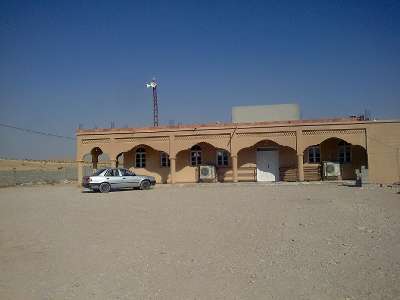
النتيجة:
نلاحظ من خلال ما سبق وبناء على المرويات أن الحيز السماوي الذي
كان مسرحا للتحري ولرؤية الهلال بعيدا كل البعد عن موضع الهلال الحقيقي
المستدل عليه بالحسابات الفلكية، ولكن بحسب الشهود فقد كانت السماء
غائمة وتغطي ارتفاعا معتبرا فوق الأفق، أضف إلى ذلك الارتفاع التقديري
للهلال الذي ذكره السيد يحي الشريف وهو متر ونصف المتر فوق الغيم وعليه
فما رؤي لم يكن الهلال، بل هذه الشهادة مردودة لمناقضتها الواقع العلمي
والنتائج الحسابية مناقضة عجيبة، ولانريد من هذا القدح أوالتشكيك في
نوايا المسلمين بل هي دعوة للتثبت والتروي في قبول دلائل الشهادة
وتمحيصها من طرف متخصصين ملمين بحيثيات المسألة. إذ كان يكفي ممن هو
مسؤول عن هذا الأمر أن يدخل إحداثيات موقع الرصد ووقت المشاهدة في
برنامج كبرنامج ستيلاريوم ويقارن بين الحالة الفلكية وهي غياب القمر
بخمسة درجات تقريبا تحت الأفق وشهادة المترائين، ليكتشف البون الشاسع
بين ما قالوا وبين الحالة الفلكية الحقيقية. ثم إن الزيادة إلى ذلك
الارتفاع الذي ذكره الشاهد وهو متر ونصف متر فوق الأفق زادتني يقينا
بمناقضة الشهادة للسنن الكونية الربانية في حركة الأفلاك السماوية
المثبتة علميا حتى تكاد نتائجها المجربة أن تصل إلى اليقين.
والله من وراء القصد وهو يهدي السبيل وصلى وسلم على نبينا محمد وعلى
آله وصحبه أجمعين.
|
Explaining the yearly Saudi visual miracle :
How a dynasty of "Chaouafa" has dictated its "law" to Saudi Arabia
All the details in the Al-Mazini Report Here.
Originally published by the Al-Sharq Saudi newspaper
The Contradictions of the Prince of "Chaoufa"
"Why following him is actually detrimental to the Sunna!"
Another insightful report from Hamza Al-Mazini
Originally published Here
تناقضات أمير الشوافة: عبدالله الخضيري
|
The Incoherencies
of the National Crescent Committee
Double talk and contradiction ...
- More thoughts on this: "Critères à géométrie variable" and a fuller analysis Here
- More on the art of dissimulation in the Crescent Committee press releases
Science as an Option
The National Crescent Committee decided at its Ramadhan 29th meeting on Friday 17, 2012 that:
1- In the light of the non-observation of the crescent across Algeria
and conspicuously:
2-
Because of the impossibility of such a sighting
the month of Ramadhan this year will count 30 days and thus the Eid will be celebrated on Sunday 19 of August 2012.
Now leaving aside the point that the impossibility of its observation should have made the sighting exercise itself unnecessary, what is remarkable is that they have the audacity to bring forth the scientific impossibility, argument they didn't present for the Ramadhan crescent on the 19th of July, and which was declared seen despite its astronomical impossibility! Likewise, for the Eid crescent of last year which, despite being unobservable because the Moon was setting before the Sun, was claimed to have been sighted properly (Thoubout Ar-Ruyya).
In fact, the following document, which is an extract from a longer letter send to Sirius by the spokesman of the Ministry of Religious Affairs, documents that on paper the first condition to accept a crescent sighting is its scientific observability (Imkan A-Ruyya criteria). This is emphasized at the end of the letter stating that the acceptation and rejection of a reported sighting is on the basis of its astronomical observability. Yet this very prime condition is dispensable as we have seen in the starting of the Ramadhan this year and in so many instances in the past.
Is there any clearer example of doubletalk, or to be kind, of schizophrenia?

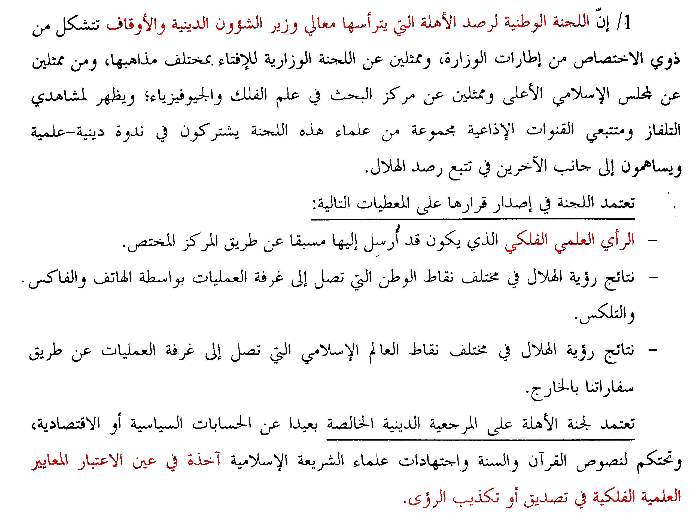
The Minister know /doesn't know
Then it is claimed by Adda Fellahi, the Ministry of Religious Affairs spokesman himself
in the El-Chourouk article (15 Aug 2012) below, stressing the independency of the Crescent Committee, that even the Ministry doesn't know the result of the deliberations and
he learn about it, like any Algerian citizen, through the
Committee's official annoucement. Now it is the very same Ministry who presides over the
Crescent Committee as we see in the letter above, and as emphasized in so many other instances in the past! See for another example the article last year on the composition of the Crescent Committee (Chourouk Sept 7, 2010) where Adda Fellahi himself explicitely stated that the Minister is a member of the Committee. Can there be a more blatant contradiction?
At the end, where is the truth?
|
لجنة الأهلة لن تشهد شهادة الزور وتقرّ بهلال الإفطار دون رؤيته
مستشار وزير الشؤون الدينية لـ'الشروق ":
الشروق اليوميالشروق اليومي : 15 - 08 - 2012
...
وأفاد المستشار الإعلامي بوزارة الشؤون الدينية والأوقاف عدّة فلاحي،
في تصريح ل "الشروق":
وقال فلاحي "إذا ثبت الهلال، فالهلال الجزائري هو المعمول به ولا إيحاءات من جهات أخرى خاصة، في فصل الصيف الرؤية متاحة عكس الشتاء، وللرأي العام رئيس الجمهورية والوزير لا يعلمان بثبوت شوال إلا كمواطنين عاديين، والعلماء لا يشهدون شهادة زور استجابة لقرار سياسي
...".
|
|


















